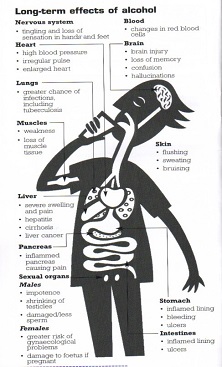|
page 2 of 11
Stages of Alcohol Influence
Drivers who exceed the per se breath or blood alcohol concentration (BAC) limit are prosecuted for having an amount of alcohol in their body which is greater than is permitted by law. Drivers are guilty of DUI simply for having violated the per se ("in and of itself") BAC limit. In California, per se BAC limit varies depending on the age of the driver, type of the driver, and whether it is a criminal or civil offense. Below is the California DUI Law Highlights for 21 and over:
|
"Per Se" BAC Level
|
"Zero Tolerance" BAC Level
|
Enhanced Penalty BAC Level
|
"Implied Consent" Law
|
|
0.08
|
0.01
|
0.15
|
YES
|
Here are some specific effects related to the Blood Alcohol Concentration (BAC). The effects of alcohol intoxication are greatly influenced by individual variations among users. Some users may become intoxicated at a much lower Blood Alcohol Concentration (BAC) level than is shown.
0.02-0.03 BAC:
No loss of coordination, slight euphoria and loss of shyness. Depressant effects are not apparent.
0.04-0.07 BAC:
Feeling of well-being, relaxation, lower inhibitions, sensation of warmth. Euphoria. Some minor impairment of reasoning and memory, lowering of caution. At .07 BAC, one experiences slight impairment of balance, speech, vision, reaction time, and hearing. Judgment and self- control are reduced, and caution, reason and memory are impaired.
0.08-0.125 BAC:
Significant impairment of motor coordination and loss of good judgment. Speech may be slurred; balance, vision, reaction time and hearing will be impaired. Euphoria. It is illegal to operate a motor vehicle at this level of intoxication.
0.13-0.15 BAC:
Gross motor impairment and lack of physical control. Blurred vision and major loss of balance. Euphoria is reduced and dysphoria is beginning to appear.
0.16-0.20 BAC:
Dysphoria (anxiety, restlessness) predominates, nausea may appear. The drinker has the appearance of a "sloppy drunk."
0.25 BAC:
Needs assistance in walking; total mental confusion. Dysphoria with nausea and some vomiting.
0.30 BAC:
Loss of consciousness.
0.40 BAC and up:
Onset of coma, possible death due to respiratory arrest.
The Effects of Alcohol and/or Medication

It is against the law to operate a motor vehicle under the influence of alcohol or other drugs, and doing so poses a serious risk to you and those around you. If you are in doubt as to whether or not a certain medication or alcoholic beverage has left you impaired, it is probably better not to drive. If it is imperative that you travel, take a cab or have a friend or family member take you.
When alcoholic beverage is consumed, it passes down the esophagus through the stomach and into the small intestine. The molecular structure of ethyl alcohol is comprised of carbon hydrogen and oxygen: C2H5OH.
Alcohol is a downer that reduces activity in the central nervous system. When the person is intoxicated, he or she exhibits or experiences symptoms such as loose muscle tone, loss of fine motor coordination, and drunken gait. The eyes appear somewhat "glossy" and pupils may respond slowly to stimulus. If alcohol is ingested at high concentrations, pupils may become constricted. Vital signs at intoxicated level can include symptoms such as worsened respiration rate, decreased blood pressure and heart rate, and decreased reflex responses.
Also, an intoxicated person may experience profuse sweating. Overall, an intoxicated person can be identified by loose fine motor coordination, odor of alcohol on the breath, and a staggering, drunken gait.
Here is a breakdown of effects of alcohol on how you feel and how your body reacts:
Brain: Alcohol is a "downer," It directly affects the brain cells. Unclear thinking, staggering and slurred speech may result. Large amounts of alcohol may cause unconsciousness or death.
Eyes: Alcohol causes blurred vision.
Heart: Alcohol can increase the workload of the heart. Irregular heartbeat, high blood pressure can result.
Liver: Alcohol can poison the liver. Prolonged use causes extensive damage and failure.
Stomach/Pancreas: Alcohol irritates the digestive system. Vomiting and ulcers may result.
Kidneys: Alcohol can stop the kidneys from maintaining a proper balance of body fluids and minerals.
Veins/Arteries: Alcohol widens blood vessels causing headaches and loss of body heat.
Blood: Alcohol reduces your body’s ability to produce blood cells resulting in anemia and/or infections.
Muscles: Alcohol can cause muscle weakness, including the heart muscle.
How to Identify and Avoid Drunk Drivers
Listed below are clues suggested by the National Highway Traffic Safety Administration (NHTSA) as ways to distinguish between nighttime drunk and sober drivers.
Turning with a wide radius.
Straddling the center of the road or lane marker.
Appearing to be drunk (eye fixation, face close to windshield, drinking in the vehicle).
Almost striking an object or other vehicle.
Weaving or zigzagging across the road.
Driving on other than a designated roadway.
Swerving or abruptly turning away from a generally straight course.
Turning abruptly or illegally.
Driving slower than 10 mph below speed limit.
Stopping without cause in a traffic lane.
Stopping inappropriately (other than in lane).
Following others too closely.
Drifting or moving in a straight-line at a slight angle to the roadway.
Erratic braking.
Driving into opposing or crossing traffic.
Signaling that is inconsistent with driving actions.
Slow response to traffic signals (sudden stop, delayed start).
Driving with headlights off.
When you spot drivers who perform these types of behaviors, the best solution would be to stay away as far as possible in order to avoid a collision.
Alternatives to Drinking and Driving
When driving-impaired, you will jeopardize yours and other drivers’ safety. So, planning ahead would be a clever step. If driving to that certain event, whether it is a party, wedding, or any other social event, select a designated driver, who would be willing to stay sober that evening. Although, if you are planning to get to that certain event alone and have a drink, take some alternate way of getting there, such as taking a cab or using public transportation. Remember that taking a chance and thinking that you can still make it or you are sober enough to drive can lead to severe, irreversible consequences.
|








